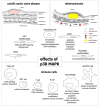Role of p38 MAPK in Atherosclerosis and Aortic Valve Sclerosis
- PMID: 30486366
- PMCID: PMC6321637
- DOI: 10.3390/ijms19123761
Role of p38 MAPK in Atherosclerosis and Aortic Valve Sclerosis
Abstract
Atherosclerosis and aortic valve sclerosis are cardiovascular diseases with an increasing prevalence in western societies. Statins are widely applied in atherosclerosis therapy, whereas no pharmacological interventions are available for the treatment of aortic valve sclerosis. Therefore, valve replacement surgery to prevent acute heart failure is the only option for patients with severe aortic stenosis. Both atherosclerosis and aortic valve sclerosis are not simply the consequence of degenerative processes, but rather diseases driven by inflammatory processes in response to lipid-deposition in the blood vessel wall and the aortic valve, respectively. The p38 mitogen-activated protein kinase (MAPK) is involved in inflammatory signaling and activated in response to various intracellular and extracellular stimuli, including oxidative stress, cytokines, and growth factors, all of which are abundantly present in atherosclerotic and aortic valve sclerotic lesions. The responses generated by p38 MAPK signaling in different cell types present in the lesions are diverse and might support the progression of the diseases. This review summarizes experimental findings relating to p38 MAPK in atherosclerosis and aortic valve sclerosis and discusses potential functions of p38 MAPK in the diseases with the aim of clarifying its eligibility as a pharmacological target.
Keywords: MAPK; aortic valve sclerosis; aortic valve stenosis; atherosclerosis; p38.
Conflict of interest statement
The authors declare no conflict of interest.
Figures

Similar articles
-
TGF-beta1-Induced MAPK activation promotes collagen synthesis, nodule formation, redox stress and cellular senescence in porcine aortic valve interstitial cells.J Heart Valve Dis. 2013 Sep;22(5):621-30. J Heart Valve Dis. 2013. PMID: 24383372
-
Pro-Calcifying Role of Enzymatically Modified LDL (eLDL) in Aortic Valve Sclerosis via Induction of IL-6 and IL-33.Biomolecules. 2023 Jul 7;13(7):1091. doi: 10.3390/biom13071091. Biomolecules. 2023. PMID: 37509127 Free PMC article.
-
Interleukin-32 plays an essential role in human calcified aortic valve cells.Eur Cytokine Netw. 2018 Mar 1;29(1):36-47. doi: 10.1684/ecn.2018.0407. Eur Cytokine Netw. 2018. PMID: 29748157
-
Bicuspid aortic valve, atherosclerosis and changes of lipid metabolism: Are there pathological molecular links?J Mol Cell Cardiol. 2019 Apr;129:231-235. doi: 10.1016/j.yjmcc.2019.03.004. Epub 2019 Mar 11. J Mol Cell Cardiol. 2019. PMID: 30872037 Review.
-
Aortic valve disease in diabetes: Molecular mechanisms and novel therapies.J Cell Mol Med. 2021 Oct;25(20):9483-9495. doi: 10.1111/jcmm.16937. Epub 2021 Sep 24. J Cell Mol Med. 2021. PMID: 34561944 Free PMC article. Review.
Cited by
-
Erythrocyte mitogen-activated protein kinases mediate hemolytic events under osmotic and oxidative stress and in hemolytic diseases.Cell Signal. 2022 Nov;99:110450. doi: 10.1016/j.cellsig.2022.110450. Epub 2022 Aug 25. Cell Signal. 2022. PMID: 36029940 Free PMC article.
-
Role of the Autism Risk Gene Shank3 in the Development of Atherosclerosis: Insights from Big Data and Mechanistic Analyses.Cells. 2023 Oct 30;12(21):2546. doi: 10.3390/cells12212546. Cells. 2023. PMID: 37947623 Free PMC article.
-
Exploring the Therapeutic Mechanism of Tingli Dazao Xiefei Decoction on Heart Failure Based on Network Pharmacology and Experimental Study.Evid Based Complement Alternat Med. 2021 Nov 25;2021:6645878. doi: 10.1155/2021/6645878. eCollection 2021. Evid Based Complement Alternat Med. 2021. PMID: 34868332 Free PMC article.
-
Effects of frog skin peptide temporin-1CEa and its analogs on ox-LDL induced macrophage-derived foam cells.Front Pharmacol. 2023 Mar 20;14:1139532. doi: 10.3389/fphar.2023.1139532. eCollection 2023. Front Pharmacol. 2023. PMID: 37021059 Free PMC article.
-
Mitogen-Activated Protein Kinases: Functions in Signal Transduction and Human Diseases.Int J Mol Sci. 2019 Sep 29;20(19):4844. doi: 10.3390/ijms20194844. Int J Mol Sci. 2019. PMID: 31569533 Free PMC article.
References
-
- World Health Organization Cardiovascular Diseases. [(accessed on 10 September 2018)]; Available online: http://www.euro.who.int/en/health-topics/noncommunicable-diseases/cardio....
-
- Banach M., Serban C., Sahebkar A., Mikhailidis D.P., Ursoniu S., Ray K.K., Rysz J., Toth P.P., Muntner P., Mosteoru S., et al. Impact of statin therapy on coronary plaque composition: A systematic review and meta-analysis of virtual histology intravascular ultrasound studies. BMC Med. 2015;13:229. doi: 10.1186/s12916-015-0459-4. - DOI - PMC - PubMed
-
- Osnabrugge R.L.J., Mylotte D., Head S.J., van Mieghem N.M., Nkomo V.T., LeReun C.M., Bogers A.J.J.C., Piazza N., Kappetein A.P. Aortic stenosis in the elderly: Disease prevalence and number of candidates for transcatheter aortic valve replacement: A meta-analysis and modeling study. J. Am. Coll. Cardiol. 2013;62:1002–1012. doi: 10.1016/j.jacc.2013.05.015. - DOI - PubMed
Publication types
MeSH terms
Substances
LinkOut - more resources
Full Text Sources
Medical

